Character Analysis: Top 5 Characteristics of Iconic Leads
Posted: May 11, 2023 | Updated: May 12, 2023
Posted In: Articles
What do Luke Skywalker, Walter White, Fleabag, Tony Soprano, and Daenerys Targaryen all have in common?
When posing the question to any movie critic or audience member of the last decade, they might respond with an answer that says something along the lines of… they are all “iconic,” “original,” or “groundbreaking characters.”
Following up on their response, it would be fair to ask, “well, what makes them iconic, original, or groundbreaking?” You’d likely be left with a blank stare or long pause.
Iconic film and television characters are almost impossible to fully articulate, yet viewers everywhere instantly recognize one when they see one.

For as long as storytelling has existed, iconic lead characters have captivated audiences with their compelling personalities, unique traits, and powerful impact on the plot.
Whether it be in literature, film, television, or any other form of media, a great lead character can elevate a story from average or good, to unforgettable.
But what exactly makes a lead character truly iconic? What qualities and characteristics (or lack thereof) must they possess to leave a lasting impression on viewers long after the movie or show has ended?
Any character analysis worth its weight will tell you that there is no one essential trait or quality that separates a legendary character from a basic one, but rather the compilation or combination of factors that places them as a standout.
This character analysis will explore the top 5 characteristics of iconic lead characters to examine the differences between them and their less memorable counterparts.
From their moral compass to their vulnerability, we will delve into all of their defining traits to provide you with a deeper understanding of what it takes to create a great lead that will stand the test of time, and ultimately, why great characters make for such compelling stories.
The Media Psychology Behind Audience Favorites
Powerful or defining characters are essential to story success, but many storytellers aren’t aware of how data and character analysis can be used to measure representation, personalities, interactions, and more.
StoryFit’s Media Psychology researcher Rob Lewis, P.h.D, and Matthew Grizzard, P.h.D and Associate Professor of Communication at The Ohio State University, explore this topic more in depth in this webinar.
Their character analysis findings suggest that frequent major character interactions in specific genres (like Drama) have a significant impact on the success of the content.
As media psychologists, they also seek to understand character liking and experimental settings in audience responses to media characters.
In the webinar, Grizzard reiterates that the best social scientific theory for understanding the appeal of narratives and media characters is Dolf Zillmann’s Affective Disposition Theory (ADT)
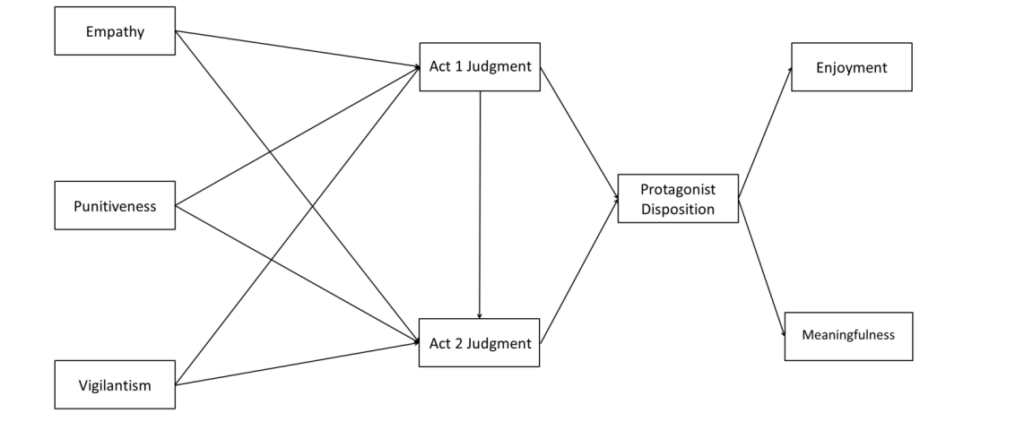
This theory tells us that the most important causal factors for enjoyment of a narrative or story is how much we like the characters and the fates that befall them.
Character likability doesn’t mean they have to be good or moral characters for audiences to like them, rather they need to have story outcomes that correspond to their morals.
Audiences like when good things happen to liked characters and bad things happen to disliked characters.
Which leads into the 1st characteristic of an iconic movie or T.V. character: likability.
#1 They are Likable.
Character likability is often seen as a gold standard quality for audience perception and enjoyment. When a main character is well-liked, they are rooted for, provoking both resonance and greater support from viewers.
This doesn’t mean a main character has to be inherently good to be well-liked – in fact, perhaps the contrary.
Media psychologists like Grizzard confirm that from significant character analysis, character likability is closely tied to relatability.
A crucial element in any form of storytelling, relatability incentives both audience empathy and understanding. As viewers, we get to see how these characters’ motivations, desires, and struggles affect their actions and decisions, providing insight behind why they might go to some of the lengths they do.
Relatable qualities help a main character to become more flawed or “human,” and we as viewers are able to see our own characteristics through them.
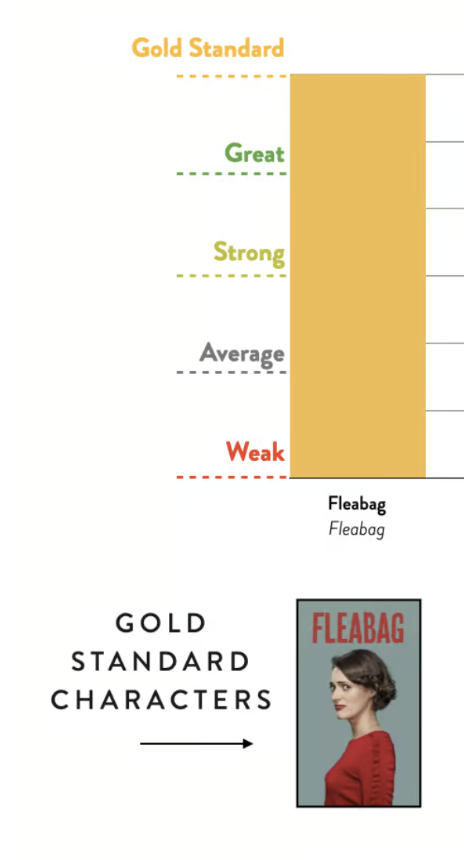
Take the character Fleabag as an example. Our character analysis confirms that she indexes highly for traits like Brutal, Greedy, Crude, and Vulgar – becoming an anti-hero of sorts.
However, it is precisely these negative qualities she demonstrates that enhances her realism and overall likability.
She is flawed and imperfect, and that makes her a main character viewers are compelled to watch.
#2 They Have Strong Character Dialogue.
An iconic character is only as strong as the words they say.
Dynamic character dialogue is an essential component of storytelling and allows for writers to shape their stories in unique ways which effectively alter the narrative course or plot line.
Almost all information a viewer can glean about a character is expressed through his/her dialogue. It is the method a writer uses to develop and unveil distinct character traits, emotions, and motivations, simultaneously advancing the plot and stage direction of the story.
There’s no doubt an iconic lead has strong dialogue, but what does strong dialogue entail?
A combination of factors, most notably:
- Characterization – The dialogue should reveal the personalities, attitudes, and motivations of the characters speaking and interacting with one another. Each character should have a voice unique to their own personality.
- Subtext – What’s left unsaid in a conversation can be just as important (if not more so) than what’s audibly expressed in character interaction. This is the underlying meaning behind the spoken words and the best characters use these tactics frequently.
- Conflict – The heart of drama and tension, conflict should be used to demonstrate character motives, but also work to demonstrate differences in characters. Where there is conflict in dialogue, there is depth in storyline.
- Purpose – Every word spoken (or not spoken) should serve a useful purpose. How are the conversations or words being used? To advance the plot? Reveal character goals? Demonstrate emotional intensity? These factors all make for strong dialogue.
Iconic leads use dialogue to reveal more to viewers about their character’s personality throughout a story. Their dialogue is also well distributed throughout the story.
Main characters that speak or change action in various scenes are more likely to be regarded as effective leads than characters that drop off at key points or leave the story completely.
Our AI character analysis analyzes this type of dialogue via our Character Blueprint graphic.
StoryFit’s Character Blueprint consists of a scene-by-scene breakdown for all major and minor characters within the script that speak or have presence within a scene. If they are referenced in the story, but are not written to be physically present or have no spoken dialogue, they do not appear in the blueprint.
Learn more about dynamic character development and the ways in which AI enriches this process in this read.
Let’s use one of the most iconic fictional characters that exists as an example: Harry Potter.
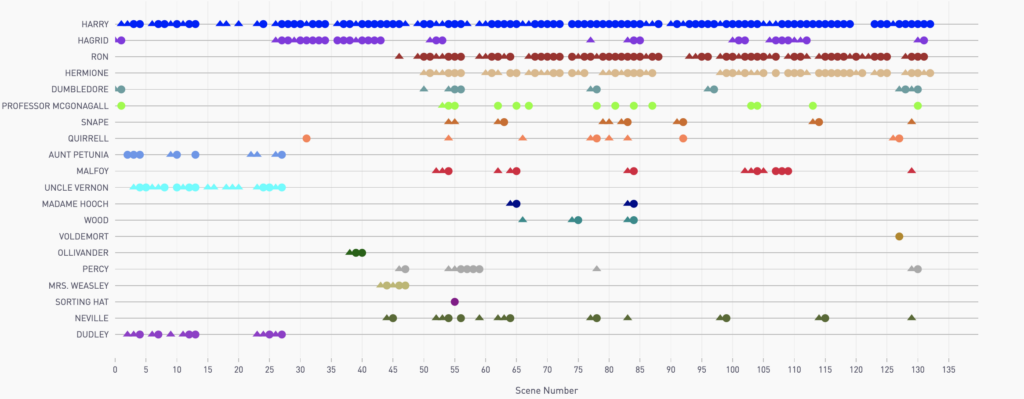
Harry Potter and the Sorcerer’s Stone Character Blueprint is a great example of a successful leading presence. Harry is the series’ primary lead, and both his dialogue (speaking) and presence (action) in all acts of the first film signify his importance to the narrative.
As any viewer can attest to, secondary characters are just as vital to a narrative as the lead of a story. Harry would be a static character without the loyal support of Ron and Hermione and the rest of the Wizarding World of Hogwarts.
They provide alternative perspectives, adding complexity to the plot and helping audiences understand the story’s world better. Secondary characters also create conflict, which as we mentioned earlier makes for inherently strong dialogue. These elements bring audience focus towards a protagonist’s strengths and weaknesses and add richness and depth to the story.
#3 They Demonstrate Unique Personalities.
A truly iconic lead character stands out from the crowd with their unique personality. They have distinct quirks, flaws, and strengths that make them unforgettable and keep the audience engaged at all times.
Here’s a list of just a few of the character traits our AI character analysis engine registers when evaluating a strong lead or supporting character’s personality:
- Anxious
- Heroic
- Greedy
- Likable
- Thought-Provoking
- Narcissistic
- Keeps Promises
- Altruistic
- Multi-Dimensional
Iconic characters often possess a mix of both positive and negative traits, which increases their character relatability, and subsequently their audience likability.
One of the most noteworthy and complex characters ever created for T.V. was Walter White, a highly skilled chemist turned high school teacher who begins selling methamphetamine with a student when he is diagnosed with cancer.
Walt, along with other characters recognized within our database, have traits that are separated into three three primary categories: Audience Perception (traits relating to how an audience feels about a character when watching them), Motives (traits that signify what the character is motivated by, what their drivers are), and Behavior (traits specific to direct or intended action).

Walt captivates us with his compelling character traits in the pilot, with consistent markers that maintain audience interest and “forgiveness” (Likable, Authentic, Competitive).
So why are audiences so drawn to complex characters like Walter White? He’s hard to predict!

A complex character can be the signature for a title — their unique combination of character traits makes them interesting to watch and hard to predict.
Characters like Walt (Breaking Bad), Dexter (Dexter), and Will Graham (Hannibal) raise the bar high for character transformation — even throughout their respective first seasons.
While these characters are known for their Narcissism, Brutality, and Selfishness (primarily negative traits), all three also register as highly Creative, Innovative, Skilled, and Unique Thinkers who take viewers on a journey that has us sitting on the edge of our seats wondering what they’ll do next.
#4 They’re Well Developed.
Over the course of a story, iconic lead characters undergo significant growth and change. They learn from their experiences and evolve (and devolve) as people, making them even more compelling and relatable to audiences.
Examining our character analysis tool helps us evaluate the strength of a script’s major and minor characters.
The character analysis score is an overall indicator of a character’s potential, as our AI engine measures the defining traits that an audience will recognize. Strong characters are the foundation of good stories. A higher score is always better, as this character assessment correlates to the success of a film or series.
But how are character scores determined?
Character scores are a compilation of a character’s prominent and impact level traits (traits that index in the top 25% and 10% for all characters within the genre).
You can learn more about character scores and Gold Standard characters in this character analysis essay.
For example, if a lead in a Romantic Comedy indexes in the top 10 or 25% for all characters within that genre for traits like Love’s Family, Authentic, Multi-Dimensional, and Thought Provoking, they would have a character score of 4.
Fleabag (Fleabag), Cohle (True Detective), Marty (Ozark), Walt (Breaking Bad) and Beth (The Queen’s Gambit) all register as having Gold Standard character scores!
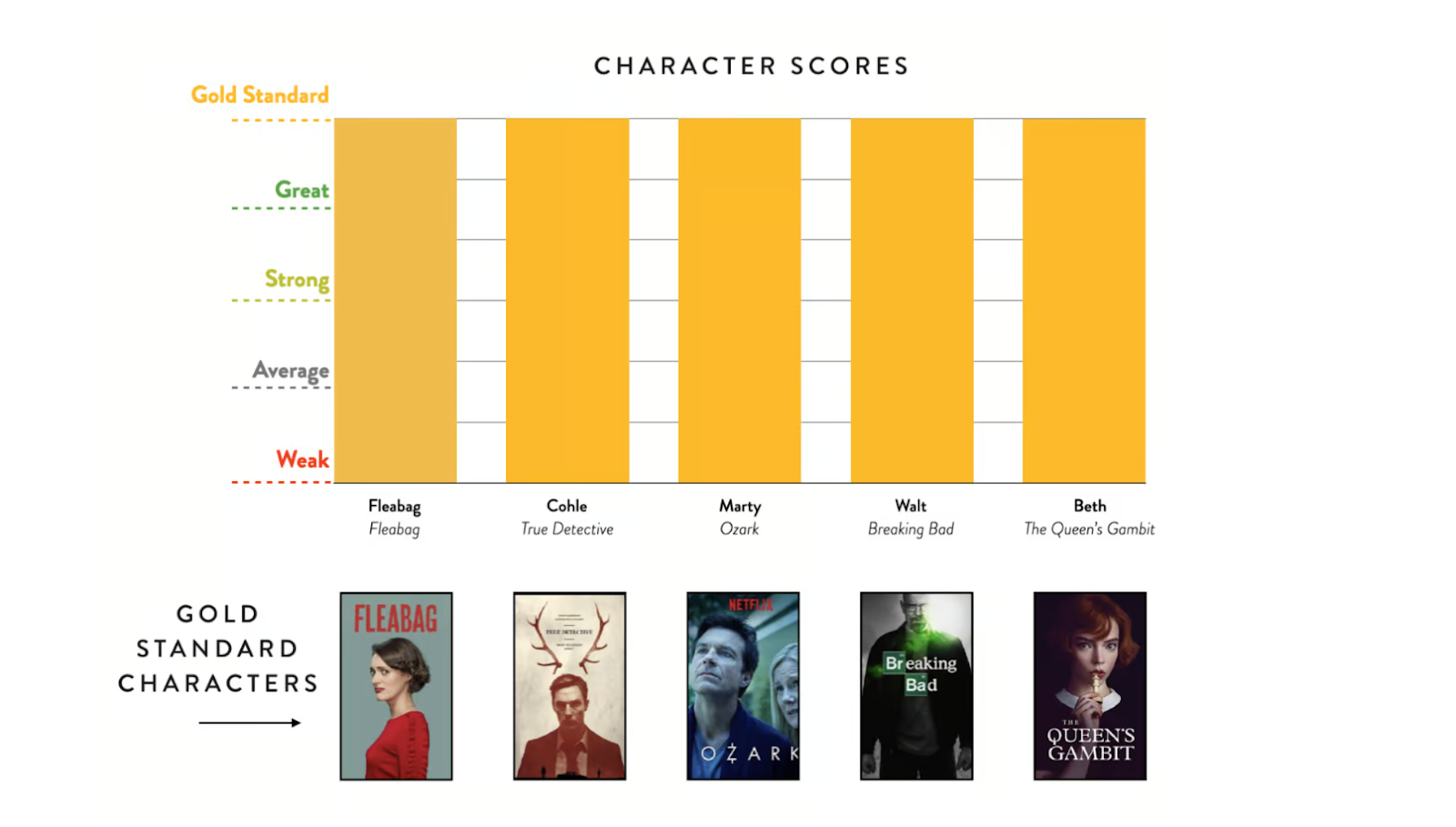
#5 They Come From Unique and Diverse Story Worlds.
There’s no doubt that Jake Sully is an iconic character, but his characteristics are heightened by the fictional story world he navigates (Pandora) and the dynamic supporting characters he interacts with.
Just like in the case of Avatar, the strength of a lead often depends on the incorporation and involvement of significant secondary characters.
StoryFit evaluates these relationships through a complex character analysis graphic we like to call our Character Network.
Acting as a visual map of a script’s main and secondary characters’ interactions, the network also visualizes and quantifies the following:
- Counts of major characters (we count major characters as any with 10% or more of dialogue as marked in the script), supporting characters (between 4% and 9% of dialogue), and minor characters (3% or less of dialogue)
- Centrality, which measures the percentage of shared interactions between characters. A lead with a high level of centrality is more likely to be considered strong.
- Percentage of scenes a character appears in vs. percentage of scenes they speak in.
- Characters that interact the most together – a sufficient way to determine important relationships to the script and identify if they are aligned with the writer’s intentions
The hilarious buddy comedy, The Other Guys, boasts a sprawling Character Network to amp up the strength of its leads, Allen and Tarry.
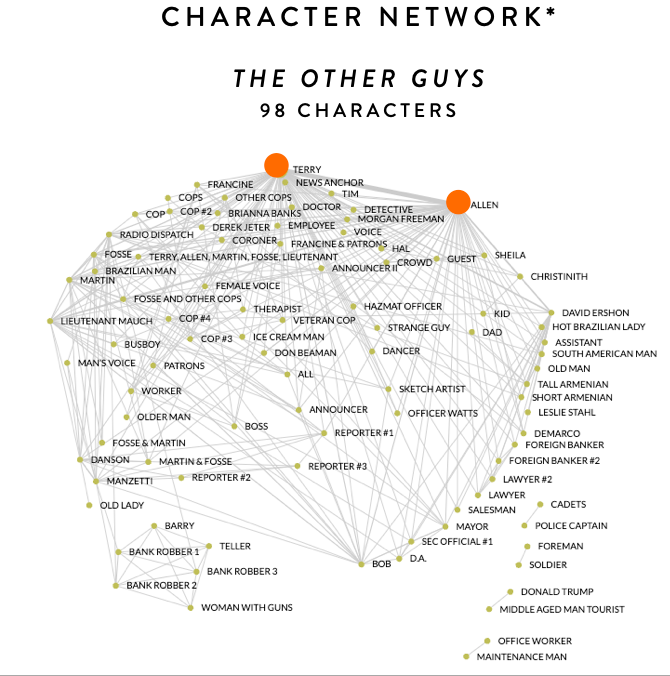
With a larger character network, action comedies like this one allow more room for character building and backstory creation within the plot.
By allowing audiences to see the two leads interacting with a wide variety of different kinds of characters, their unique characteristics and different personalities become more apparent, subsequently contrasting their traits and intensifying the humor of the story.
Creating an iconic character is no easy feat, but when implementing these Top 5 Characteristics for your story’s lead, you’ll be sure to score a win with audiences everywhere.
Worried you have a static character? Want to know which audiences are the best fit for your story? Contact StoryFit. We can help.
